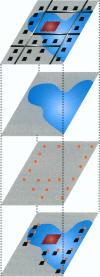Abstract
Advances in geographic information system (GIS) technology, developed by geographers, provide new opportunities for environmental epidemiologists to study associations between environmental exposures and the spatial distribution of disease. A GIS is a powerful computer mapping and analysis technology capable of integrating large quantities of geographic (spatial) data as well as linking geographic with nongeographic data (e.g., demographic information, environmental exposure levels). In this paper we provide an overview of some of the capabilities and limitations of GIS technology; we illustrate, through practical examples, the use of several functions of a GIS including automated address matching, distance functions, buffer analysis, spatial query, and polygon overlay; we discuss methods and limitations of address geocoding, often central to the use of a GIS in environmental epidemiologic research; and we suggest ways to facilitate its use in future studies. Collaborative efforts between epidemiologists, biostatisticians, environmental scientists, GIS specialists, and medical geographers are needed to realize the full potential of GIS technology in environmental health research and may lead to innovative solutions to complex questions.
Full text
PDF







Images in this article
Selected References
These references are in PubMed. This may not be the complete list of references from this article.
- Brody D. J., Pirkle J. L., Kramer R. A., Flegal K. M., Matte T. D., Gunter E. W., Paschal D. C. Blood lead levels in the US population. Phase 1 of the Third National Health and Nutrition Examination Survey (NHANES III, 1988 to 1991) JAMA. 1994 Jul 27;272(4):277–283. doi: 10.1001/jama.272.4.277. [DOI] [PubMed] [Google Scholar]
- Frisch J. D., Shaw G. M., Harris J. A. Epidemiologic research using existing databases of environmental measures. Arch Environ Health. 1990 Sep-Oct;45(5):303–307. doi: 10.1080/00039896.1990.10118749. [DOI] [PubMed] [Google Scholar]
- Glass G. E., Schwartz B. S., Morgan J. M., 3rd, Johnson D. T., Noy P. M., Israel E. Environmental risk factors for Lyme disease identified with geographic information systems. Am J Public Health. 1995 Jul;85(7):944–948. doi: 10.2105/ajph.85.7.944. [DOI] [PMC free article] [PubMed] [Google Scholar]
- Greenland S., Morgenstern H. Ecological bias, confounding, and effect modification. Int J Epidemiol. 1989 Mar;18(1):269–274. doi: 10.1093/ije/18.1.269. [DOI] [PubMed] [Google Scholar]
- Greenland S., Robins J. Invited commentary: ecologic studies--biases, misconceptions, and counterexamples. Am J Epidemiol. 1994 Apr 15;139(8):747–760. doi: 10.1093/oxfordjournals.aje.a117069. [DOI] [PubMed] [Google Scholar]
- Guthe W. G., Tucker R. K., Murphy E. A., England R., Stevenson E., Luckhardt J. C. Reassessment of lead exposure in New Jersey using GIS technology. Environ Res. 1992 Dec;59(2):318–325. doi: 10.1016/s0013-9351(05)80038-6. [DOI] [PubMed] [Google Scholar]
- LEMBERSKII I. G. K voprosu o chastote perekhoda zakrytykh form tuberkuleza legkikh v otkrytve. Probl Tuberk. 1951 Sep-Oct;5:58–60. [PubMed] [Google Scholar]
- Morgenstern H. Ecologic studies in epidemiology: concepts, principles, and methods. Annu Rev Public Health. 1995;16:61–81. doi: 10.1146/annurev.pu.16.050195.000425. [DOI] [PubMed] [Google Scholar]
- Stallones L., Nuckols J. R., Berry J. K. Surveillance around hazardous waste sites: geographic information systems and reproductive outcomes. Environ Res. 1992 Oct;59(1):81–92. doi: 10.1016/s0013-9351(05)80227-0. [DOI] [PubMed] [Google Scholar]
- Thomas J. C., Schoenbach V. J., Weiner D. H., Parker E. A., Earp J. A. Rural gonorrhea in the southeastern United States: a neglected epidemic? Am J Epidemiol. 1996 Feb 1;143(3):269–277. doi: 10.1093/oxfordjournals.aje.a008738. [DOI] [PubMed] [Google Scholar]
- Twigg L. Health based geographical information systems: their potential examined in the light of existing data sources. Soc Sci Med. 1990;30(1):143–155. doi: 10.1016/0277-9536(90)90337-r. [DOI] [PubMed] [Google Scholar]
- Wartenberg D., Greenberg M., Lathrop R. Identification and characterization of populations living near high-voltage transmission lines: a pilot study. Environ Health Perspect. 1993 Dec;101(7):626–632. doi: 10.1289/ehp.93101626. [DOI] [PMC free article] [PubMed] [Google Scholar]









